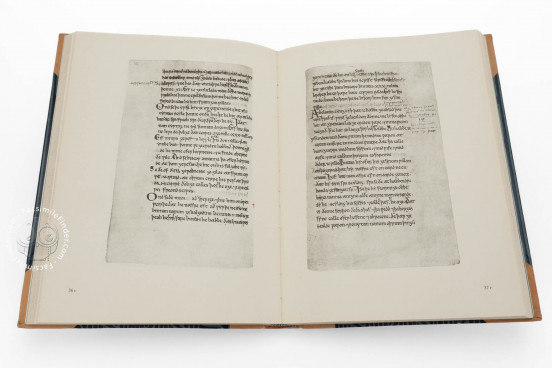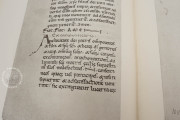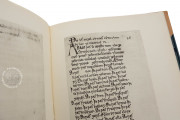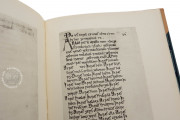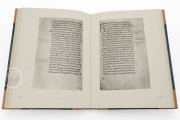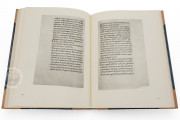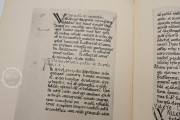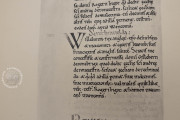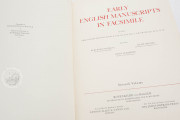The Rochester Tome, or the Textus Roffensis, is an early twelfth-century compilation in two parts. The first 118 folios are a roughly chronological copy of English laws beginning with Æthelbert's Code of ca. 600 through early eleventh-century laws on ex-communication and execution functioning as an "encyclopedia of English law" written in both Old English and Latin in Insular Minuscule and Protogothic, respectively. The Rochester Tome is the only manuscript copy for the earliest laws and thus is an important artifact for the history of the English law code.
The book's primary decoration is the historiated initial on fol. 116r, a Romanesque R featuring a nimbed standing figure with entwined dragons with foliate tails, introducing the section of the cathedral's charters and other documents. Written by the same scribe, these were bound together with the English laws by the early fourteenth century. Additional enlarged red, purple, and green initials delineate individual texts throughout. This crucial historical text also preserves important linguistic and cultural information making it worthy of the British Library's designation as a 'hidden English treasure'.
The Earliest English Laws
The primary importance of the Rochester Tome is its preservation of the earliest English law code, from the Christian conversion of the king of Kent, Æthelbert, and ending with the coronation charter of King Henry I in 1100. These laws are the foundation of the medieval English state in both content and language. The Rochester Tome stands as the only surviving copy for the three earliest of these laws.
A Most Learned Scribe
The main body of the book was written by a single scribe including few contemporary corrections and amendments. This hand is responsible for at least a dozen other manuscripts. Perhaps the prior, Ordwine, or an unknown scholar, he stands out as a remarkable individual from his broad knowledge of not only the Old English and Latin languages, but in the specific traditions pertaining to writing them.
The Latin is written in a practiced Protogothic script, typical of its time, but the Old English is written in an equally expert Insular Minuscule that had been out of general use for a century. This suggests at least some in the monastic community of England continued to pass down pre-Conquest knowledge well into the twelfth century.
Submerged in the Thames
The Rochester Tome suffered an episode of excitement in the early eighteenth century when it fell into a river, traditionally believed to be the Thames, during transport. It suffered water damage, which is still visible however fortunately it has not affected the legibility of the text.
While always held under the ownership of the cathedral, it was loaned out to many Early English scholars through the centuries including William Lombard, Thomas Leonard, Sir Roger Twysdem, and William and Elizabeth Elstob. It was previous stored by Medway Council but today is held in the cathedral crypt.
The codex showcases an eighteenth-century full red-brown leather binding crafted by Charles Lamacraft, which includes two clasps on the boards. It features blind-tooled strips that overlap around a central lozenge, all of which are ornately decorated with scrolling vines. Notably, it underwent repairs in 1937.
We have 1 facsimile edition of the manuscript "Rochester Tome": Textus Roffensis facsimile edition, published by Rosenkilde and Bagger, 1957-62
Request Info / Price
